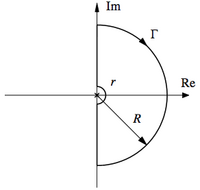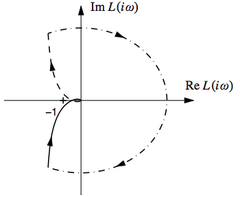FAQ: What does the Nyquist plot look like for a system with poles at the origin?
Section 9.2 and Example 9.2 in the main text describe how to sketch the Nyquist plot for a system with a pole at the origin. In general, when there are poles at the origin (or any other point along the imaginary axis), a small semi-circle is drawn to the right of the pole, creating a large circle in the Nyquist plot, as shown below:

|

|
|||
| Figure 9.3a: Nyquist D contour | Figure 9.5b: Nyquist plot |
The dash-dotted portion of the Nyquist plot on the right corresponds to the small semicircle of radius  at the origin.
at the origin.
Figuring out which way the Nyquist plot closes for a single pole at the origin
For a single pole at the origin, the Nyquist curve will approach infinity as  approaches zero from both the positive and negative direction. The Nyquist curve can then be "closed" by tracing around a small semicircle to the left of the pole (as shown in Figure 9.3a). The small semicircle will attach the two ends of the Nyquist curve at infinity by creating a large semicircle joining the two ends of the Nyquist curve. The stability of the system will often depend on whether this large semi-circle is on the right or the left of the complex plane.
approaches zero from both the positive and negative direction. The Nyquist curve can then be "closed" by tracing around a small semicircle to the left of the pole (as shown in Figure 9.3a). The small semicircle will attach the two ends of the Nyquist curve at infinity by creating a large semicircle joining the two ends of the Nyquist curve. The stability of the system will often depend on whether this large semi-circle is on the right or the left of the complex plane.
A simple way to determine on which side the Nyquist plot is closed is to evaluate the transfer function at  , where
, where  is a small, positive, real number. The transfer function will be real-valued if
is a small, positive, real number. The transfer function will be real-valued if  is real and if
is real and if  then the Nyquist plot closes on the right, otherwise on the left. This trick only works for poles at the origin and only works if there is a single pole at the origin.
then the Nyquist plot closes on the right, otherwise on the left. This trick only works for poles at the origin and only works if there is a single pole at the origin.
Multiple poles at the origin
When there are multiple poles at the origin, the magnitude of the Nyquist curve still goes to infinity near zero frequency, but one has to be more careful in determining how to close the curve. The proper way to do this is to explicitly evaluate the Nyquist curve along a semi-circle of radius  . If we let
. If we let  represent the portion of the Nyquist contour near the origin and
represent the portion of the Nyquist contour near the origin and  represent the corresponding portion of the Nyquist plot, then we have:
represent the corresponding portion of the Nyquist plot, then we have:

If  is chosen sufficiently small, then the only
is chosen sufficiently small, then the only  -dependent contribution to the Nyquist curve will be due to the poles at the origin. In this case, we can write
-dependent contribution to the Nyquist curve will be due to the poles at the origin. In this case, we can write  where
where  is the portion of the loop transfer function that has no poles at the origin and
is the portion of the loop transfer function that has no poles at the origin and  is the number of open loop poles at the origin. It follows that
is the number of open loop poles at the origin. It follows that

The contour  consists of
consists of  semicircles and hence we get one complete encirclement for every two poles at the origin. The direction of the encirclement is in the clockwise direction (since
semicircles and hence we get one complete encirclement for every two poles at the origin. The direction of the encirclement is in the clockwise direction (since  is a counterclockwise oriented segment, as shown in Figure 9.3a).
is a counterclockwise oriented segment, as shown in Figure 9.3a).
Note that if you have an odd number of poles, the two "ends" of the Nyquist curve (for positive and negative values on the  axis) will be 180 degrees apart. If you have an even number of poles, the two "ends" of the Nyquist curve will both be real and you "connect" the ends by going around in one or more complete circles. To see these effects, try drawing Nyquist curves for the following transfer functions:
axis) will be 180 degrees apart. If you have an even number of poles, the two "ends" of the Nyquist curve will both be real and you "connect" the ends by going around in one or more complete circles. To see these effects, try drawing Nyquist curves for the following transfer functions:
